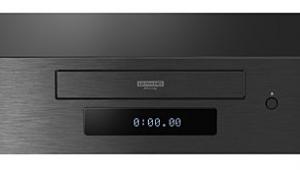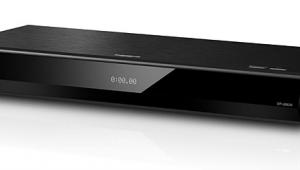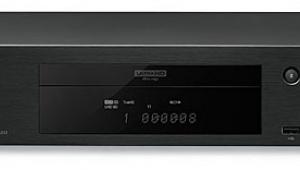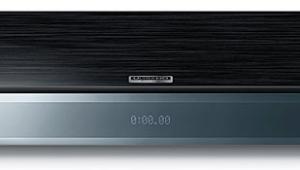Samsung BD-P1000 Blu-ray Player
With more than a little excitement, I hooked up the Samsung BD-P1000 Blu-ray disc player. Here it is, the first Blu-ray player to hit the world. I put it right on top of the Toshiba HD-XA1 HD DVD player, which I'm sure the Blu-ray people would love to hear, and the HD DVD people not so much. I ran the HDMI cable to the virtually reference-quality Yamaha DPX-1300 projector, put in my old standby The Fifth Element (of course), and sat back, ready to enjoy. The disc started up promptly (take that, Toshiba!), and, within seconds, there was Blu-ray. It only took a few seconds more before I uttered something along the lines of, "What the hell?"

Let Me Back Up
Unlike Toshiba's HD-XA1, the BD-P1000 acts and looks like a regular DVD player. Its acceptance of commands from its remote and overall usability are slower than current-model DVD players, but it puts the brutally slow HD-XA1 to shame. Then again, with an extra $300 to play with in the manufacturing ($500 over the virtually identical HD-A1), I would hope it would. After all, this isn't a computer like the Toshiba. You can't select 1080p on the Samsung; it only becomes a choice if it auto-detects that your display is 1080p (so make sure your TV is on when you plug in the BD-P1000). If your display is 720p, you can select 1080i or 720p.
The remote isn't the HD-XA1's flashy auto-illuminated brick, which is good, but it's not backlit, which is bad. So, on a functionality basis, the Samsung is a whole level better than the Toshiba, but who cares about how it is to use.
Picture Quality
It's inevitable that a review of the first Blu-ray player would also, to some extent, be a review of Blu-ray itself. After all, that was what we did with HD DVD. It turns out, we can't do that, at least not completely. The problem is multifold, and I'll start with the biggest. Take for example chapter 2 of The Fifth Element. I've seen this shot countless times on several different DVD releases, and I can't think of a time it looked worse. You read that right. It was noisy, dirty, and, worst of all, it wasn't very detailed. Sure, it looked a little more detailed than DVD but certainly not the six times better that the resolution increase would suggest. OK, now we have a problem. I had gone out the day before and purchased several Blu-ray titles in the store, really just to see if I could. I put these in, and, across the board, they were not impressive. House of Flying Daggers was noisy and soft. Terminator 2 wasn't quite as noisy, but it still wasn't as sharp as even a halfway-decent HD DVD. What's annoying about this is that all three of these films had excellent DVD transfers.
What makes all of this difficult is that there are too many variables to judge the source of the lack of picture quality. This wasn't an issue with the Toshiba player; there were HD DVD discs that looked amazing and discs that only looked OK. In that way, it was fair to assume that the player wasn't doing anything but outputting what was on the disc, for better or worse. Here, we can't make the same assumption.
The Variables
I had a number of questions. All along, we and other press have been talking about how Blu-ray's extra capacity makes it the safe bet in a format war. After all, historically speaking, the format with the greater capacity has won. But here's the catch: Most of the HD DVD titles are dual-layered 30-gigabyte discs (15 GB per layer), while none of the current 25-GB Blu-ray titles are dual-layered (as in 50 GB). So, for now, HD DVD has more capacity. HD DVD also currently uses VC-1, which is a more efficient codec than MPEG-2, which most if not all of the Blu-ray discs are using. So, does this seeming lack of space have something to do with what appear to be Blu-ray's deficiencies? It seemed possible, as most HD DVDs hold the movie plus a bunch of extras. Very few Blu-ray titles have any extras at all. While that may not interest you, it does raise the question of whether studios are running out of space on the discs thanks to the much larger MPEG-2 files.
 So, I talked to Don Eklund, executive VP of advanced technologies at Sony Pictures. According to him, they made a choice not to include 480i content as extras. They would rather just have HD extras on the BD discs, and that space wasn't the reason why there were no extras. He also mentioned that 50-GB titles would be shipping soon (including Black Hawk Down, which you should be able to get now). This is all very interesting, but it doesn't answer the main question: Why doesn't Blu-ray look very good?
So, I talked to Don Eklund, executive VP of advanced technologies at Sony Pictures. According to him, they made a choice not to include 480i content as extras. They would rather just have HD extras on the BD discs, and that space wasn't the reason why there were no extras. He also mentioned that 50-GB titles would be shipping soon (including Black Hawk Down, which you should be able to get now). This is all very interesting, but it doesn't answer the main question: Why doesn't Blu-ray look very good?
One problem is the original master. Consciously or not, Warner and Toshiba had several reference-quality titles available at launch. Sony and the gang (rather stupidly, I think) did not. They chose to release titles with the "widest cross section of interests" instead of having even one that really showed off the format's potential. Take The Fifth Element, for example. You can see a substantial amount of dirt on the film near the beginning. I guess that's as close to filmlike as you're going to get. In fact, nearly all of the titles (save the severely computer-manipulated Ultraviolet) have noticeable amounts of film grain. But, when you have something to compare it with (HD DVD), it would help if there were at least a few titles that weren't so noisy so we could have a more direct comparison (as direct as we can until the same titles are released on both formats). So, that leaves two variables: MPEG-2 and the player.
To test both, I made the trek down to Pioneer in Long Beach, California. There, product guru Chris Walker (his full title barely fits on his business card) had two identical 50-inch 1080p PRO-FHD1 plasmas that were fresh out of the box. There, Ultimate AV editor Tom Norton and I compared their prototype BDP-HD1 Blu-ray player and the Samsung BD-P1000 side by side. To be sure there was no funny business, we also swapped the TV each player was plugged into. It was soon apparent that the Samsung player was softening the image. It also looked a little desaturated. If you had nothing to compare it with, it may not have been noticeable. But we do have something to compare it with—HD DVD and, here, another BD player. Tom brought his Samsung BD-P1000 review sample down, and we also compared the component and HDMI outputs from the two players. The component looked a little brighter and perhaps a little nicer than the HDMI. There's irony for you. Rumors abound as to what is going on with the BD-P1000. (See my GearWorks on page 34 for more on that.)
Lastly, Walker showed us some clips he had encoded with MPEG-2. He encoded the same clip from a D5 master at Blu-ray's recommended 20-megabits-per-second average with a low of 15 mbps and a high of 35 mbps. Then he showed the same clip encoded at a nearly steady 35 mbps. We all agreed that maybe the 35-mbps clip looked a tiny bit more consistent, but it was so close as to not be noticeable in normal viewing. Some of the other clips he showed us, which were at BD encoding rates, looked flat-out amazing. It was the kind of pristine image and incredible detail we were hoping for with Blu-ray and have with some HD DVDs. So, from these examples, I have doubts that any of Blu-ray's picture-quality issues stem from MPEG-2. I have more info on the visit in my blog on our Website.
So Where Does This Leave Us?
The fact at the moment is this: The Samsung player softens the image from discs that weren't great to begin with. This is very disappointing, as we're going to have to wait for the next Blu-ray player to really see what the format can do. The lack of reference-level discs exacerbates the problem. As you read this, there will certainly be more titles available, and, from what Eklund said, many of them will be the reference quality we're looking for. For that, we'll have to wait and see. In the meantime, I'll be enjoying HD DVD.
Highlights
• 1080p
• The only Blu-ray player you can buy (as of this writing)
- Log in or register to post comments






























































